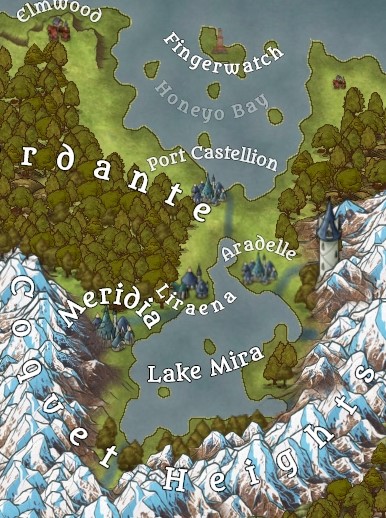History
Age of Rule
"From the peak of the Vestrial Tower, the thunderous words of the goddess may be heard throughout the land, and even the wind pays it heed." - The Book of Etiquette, "Vestria's Words"
Following the Creation of the mortal plane, the natural gods were given the
Great Task to mold it to fit humanity.
Mistra, goddess of the weather, and
Churus, god of thought, split and recombined their spirits following this to form
Vestria, ruler goddess of
Anhara. When this capricious goddess of winds and politics came into the world, she did so at the Vestrial Tower, existing in the mountains of the Coquet Heights since time immemorial.
As Anhara developed into a polity, it was molded to the image of its goddess, ruling from high atop her tower. The dizzying heights, open arches, and wind-swept peak of Vestria's seat became the inspiration for architecture throughout the capital region, particularly in
Meridia itself. Situated across
Lake Mira from the cultural capital of Anhara, aforementioned Meridia, the Vestrial Tower was the seat of government until the end of the Age of Rule.
"When supplicating, one is in the kneeling position, hands together, before extending the hands along the floor, and lowering the body to match. This position is held until acknowledgment by Vestria." - The Book of Etiquette, "Behaviour in Halls of Power"
Here, members of the nobles houses of Anhara had to climb its imposing heights, up to Vestria's throne amongst the clouds. This trip was necessary to supplicate oneself to the goddess, as flattery was the way into her ever-changing favor. The best of these supplicants, well versed in oratory, went on to form the first
Rostrum, the legislative body of Anhara, and from them the nation gained its most ancient noble houses.
However, as these politicians gained more power over Anhara and divided up lands into their own spheres, provided they could avoid the random ire of Vestria, centralisation occurred. This necessitated a place of government more accessible than a tower stretching high above mountains, especially given politicians' natural propensity towards weight. More room, and fewer stairs, demanded the expansion of Meridia. With the rise of the new capital to rival the heights of the Vestrial Tower, the government migrated as well, but maintained the tradition of sending speakers to placate Vestria. From this developed the tradition of the Patriarchs of the noble houses choosing
Rhetors who were not necessarily themselves, often younger and more charismatic, though this practice of course varied.
Age of Men
"Informed sources say excavation was completed yesterday afternoon of a cavern dating back to the Creation under the Tower, the High Priestess, however, was coy when asked about the topic." - The Whistling Observer
Following Vestria's return in
The Crossing Over, the Vestrial Tower had already fallen into disuse for governmental purposes. Thus, the
Rhetorlord and his government saw no downside to turning it over to the
College of Vestrial Priestesses.
From there, the priestesses, under the leadership of the High Priestess, modified the tower to facilitate the education and livelihood of the young women pledging themselves to Vestria's service. Rarely does a non-priestess have business in the tower, so most of it has been unseen since the earliest days of Anhara, leading to numerous theories about its use.
Architecture
"In constructing arches in the earliest manner, one need only glance across the lake to the Vestrial Tower, for who can attempt to outstyle the gods?" - Architectural Facets of the Capital
The Vestrial Tower set the precedent for architecture in Anhara, with its marble arches allowing both an aesthetically pleasing and pious way to facilitate wind-flow throughout the buildings. This was the first instance of Anhara's unique whistling sound being demonstrated, and as the pattern of arches would be replicated in the capital on a grander scale, the noise became associated more with Meridia. However, only from this tower's arches are the ashes of priestesses scattered in the
traditional manner.
Capping off the tower is the first use of
bluestone in construction. However, this predates the discovery of the material by mankind, owing to the Tower's divine origins. This has led to speculation that the top of the tower is a unique material, and that bluestone became popular as a means to replicate this. Unfortunately for historians, the High Priestess has forbidden any testing of the roof to occur, given its extreme height and the potential sacrilegious aspects.


Comments